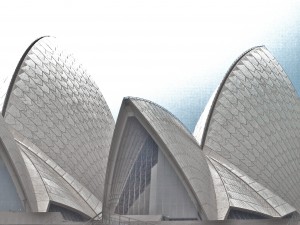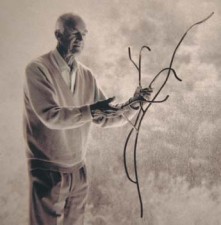Happy Birthday SOH
The Sydney Opera House celebrated its 40th birthday in October 2013. A BBC documentary called Autopsy of a Dream, made in the late 1960s and thought to be callously destroyed by timid bureaucrats threatened with legal action, was miraculously recovered, restored and screened on ABC Television to honour the event. I wrote the following piece in 2009 under the title Imbued with Sisu. It seems like a good time to publish it again.
Imbued with sisu
No matter how many times I go to the Sydney Opera House, I always experience a sense of occasion. Maybe this is how Burmese pilgrims felt when entering Rangoon to pay tribute to Buddha at the golden crested Shwedagon Pagoda; or ancient Greeks felt when they rounded a corner and caught sight of the Acropolis looming over Athens. Market stalls cling to the footsteps of the House on Sundays; people stream up and down the concourse in a never ending surge; cool jazz emanates from cocktail bars and seagulls swoop across the harbour. People sip coffee or champagne at alfresco tables, while others rush to a concert before the final gong excludes them.

photo by Howard Gwynne
All the superlatives have been exhausted when it comes to describing the Opera House’s unique sail-like design, the engineering ingenuity behind its construction, and the sheer visceral magnificence of its siting on Bennelong Point, jutting into the harbour like a supremely confident cockatoo.
Equally, pages have been devoted to the epic drama behind its history – the cost overruns; the machinations to banish architect, Jørn Utzon, and send him packing to Denmark in 1966; the compromises to his exacting design; and the fallout in terms of poor acoustic quality and interior finishes.
Jørn Utzon died in late 2008 having never returned to Sydney to see his spectacular design in its finished state. When he died the tributes flowed in. Architecture writer, Davina Jackson, gave an elegant summary of Utzon’s genius in her obituary for The Australian newspaper:
“All his compositions were precisely designed to dance to the daily nuances of sunlight, shadows, clouds and rain. An acute sensitivity to nature and people was Utzon’s genetic source of both inspiration and eternal virtue.”
There had been a significant rapprochement between Sydney and Utzon for a decade or so before his death. He was invited to oversee, at a distance, the renewal and modification of some aspects of the House in accord with his original design. This overture apparently pleased him, although his health had begun to fail by then and his son, Jan, was deputised to act in his place. At a recently held state memorial service to honour and thank Utzon, to which his son and daughter were invited (as they were to the 40th birthday celebrations along with Danish royals, Frederik and Mary), Opera House Trust Chairman, Kim Williams, confidently predicted that the $1 billion needed to complete the refurbishment of the House would be found. Politicians were notably silent about any such promises and history looks like it will repeat itself, as it has a habit of doing.
Whatever happens, Utzon and Sydney will be forever entwined.
 Utzon’s vision and unerring eye for quality was his strength and his undoing. While his glorious design is known world-wide and used as visual shorthand to conjure up Sydney, the building is encoded with an emotional legacy. I can’t look at it or be in it without registering, at some level, the sad symbolism it embodies. It’s tempting to characterise its history in black and white terms – creative genius thwarted by venal philistines. But Utzon played a role in his own downfall; his lack of strategic nous and inability to read the mood of the city and its politicians, meant he couldn’t outsmart them.
Utzon’s vision and unerring eye for quality was his strength and his undoing. While his glorious design is known world-wide and used as visual shorthand to conjure up Sydney, the building is encoded with an emotional legacy. I can’t look at it or be in it without registering, at some level, the sad symbolism it embodies. It’s tempting to characterise its history in black and white terms – creative genius thwarted by venal philistines. But Utzon played a role in his own downfall; his lack of strategic nous and inability to read the mood of the city and its politicians, meant he couldn’t outsmart them.
In 2006, expatriate Australian journalist and writer, Geraldine Brooks, went to Denmark to interview Utzon and subsequently wrote a wonderful account of her time with him. Naturally, the conversation revolved around the construction of his most famous work and his reflections about that heady and conflicted time. It was then he said:
“Everyone was doing more than their best. How can you express this? I asked a Finnish carpenter, and he said the word in Finnish is sisu – the desire for something extra that you can pull out of yourself.”
Someone who knew a thing or two about sisu, Finnish architect Alvar Aalto, one of Utzon’s mentors, is reputed to have once said: “If you want a building, you can have it now; but if you want good architecture, you’ll have to wait.” Maybe he could have given Utzon this advice, “and you’ll need sisu if you want to out-last and out-smart your critics!”
References:
Davina Jackson, ‘Jørn Utzon dies at 90’, Obituary, The Australian, December 01, 2008
Geraldine Brooks, ‘Unfinished business – Jørn Utzon reflects on his troubled masterpiece’, The Sydney Morning Herald, Good Weekend, March 18, 2006


